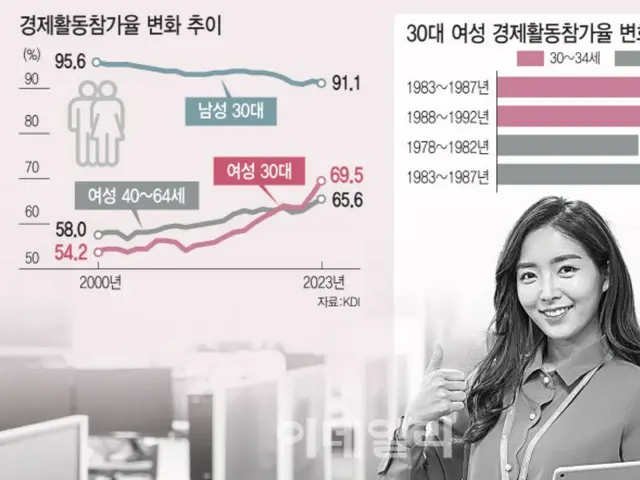She thinks she wants to. Mr. A said, ``Once I hit my 30s, I felt pressured by my family and relatives to get married early, but many of my friends and co-workers around my age were single, so I was still anxious.''
"I don't feel that way," he said. Ms. B (female, 37), a 37-year-old office worker who has been married for eight years, is most concerned about career advancement, not childbirth. It's hard to advance your career because of the title ``Mom.''
This is because I feel that it is actually difficult. Ms. B said, ``I have seen many female seniors who were delayed in promotion due to having to work and raise children at the same time, and who left the company to concentrate on raising children.''
``Companies want people who can work for long periods of time, but if you become pregnant and give birth, it will be impossible for you to get promoted or even transfer to another company,'' she said.
The recent rapid increase in the economic activity participation rate of women in their 30s is due to the fact that they either do not have children or postpone having children.
National policy research institutes have analyzed that this is due to an increase in the proportion of people who do so. According to a report titled ``Background and implications for the rise in the economic activity participation rate of women in their 30s'' released by the Korea Development Institute on the 30th.
In 2022, the economic activity participation rate for women in their 30s was 78.7% for those without children, but only 54.5% for those with children.
According to the report, women's economic participation rates by life cycle form an M-shaped curve. labor market
They enter the labor market and rise, then fall due to childbirth and child rearing, re-enter the labor market and rise, then retire and fall. Your 30s is the first decline zone of the M-shaped curve, and is the year when you reach the bottom point in the middle.
Their age is increasing year by year, from 34 years old in 2012 to 36 years old in 2017 to 38 years old in 2022. Kim JIYEON, Director of Economic Observatory Trends at the Korea Development Institute, said, ``Women in their 30s are affected by childbirth and childcare.
``This is a group whose participation in economic activities has been relatively low, but it has shown a sharp upward trend since 2010.'' He added, ``Recently, it has overtaken women aged 40 to 64, and the gap with men in their 30s has also increased. shrinkage
"I'm waiting," he explained. This phenomenon becomes even more noticeable when looking at women in their 30s, divided into 30 to 34 year olds and 35 to 39 year olds. Economic activity participation rate of people aged 35 to 39
The percentage for those aged 30 to 34 is 66.2%, while the difference is 75% and 8.8% for those aged 30 to 34. Comparing both generations, the percentage of married people increased from 65.3% to 52%, and the percentage of people with children increased to 46.9%.
% to 32.3%. In particular, the percentage of respondents with two or more children decreased significantly from 22.9% to 13.6%. On the other hand, the percentage of unmarried people sharply increased from 34.7% to 48.0%.
However, the proportion of married women without children increased from 18.4% to 19.7%. Director Kim said, ``There is an increasing number of women who are not having children or are postponing having children, starting from the age of 30 onwards.
"The primary factor behind the rise in the economic activity participation rate among women aged 4 years is the decline in the proportion of women with two or more children," he said. contributed greatly
However, this suggests that the burden of raising children remains the biggest factor inhibiting women in their 30s from participating in economic activities."
The report states that this upward trend in the economic activity participation rate of women in their 30s cannot be interpreted positively.
That's a point. In the short term, women participate in the labor market and alleviate the slowdown in the supply of labor due to demographic changes, but in the long term, as this is a phenomenon that causes the declining birthrate, the productive population will decline.
This is because it connects to a small number of people. In 2022, South Korea's total birth rate (the number of children a pregnant woman is expected to give birth to over her lifetime) remained at 0.78. Member of the Organization for Economic Co-operation and Development (OECD)
South Korea is the only country with a total birth rate of less than one child. This year, there are concerns that the number will be lower than this, dropping to around 0.6 people. International Monetary Fund (IMF) and credit rating agency Moody
Major overseas organizations, including the National Institute for Economic Research and Development, have warned that the declining birthrate and aging population will hinder the rise in South Korea's economic potential growth rate. The report proposes ``policy support for balancing work and family'' as a solution to the problem.
It shows. Director Kim said, ``While increasing the utilization of systems that support the balance between work and family for workers who are giving birth and raising children, such as systems that shorten working hours during the child-rearing period and flexible working arrangements, we are working to increase the understanding of families.
It is necessary to create a working environment that supports the economy,'' and recommends that ``policy efforts must be sustained to increase both the economic participation rate and the birth rate of women during childbirth and childcare.''
2023/10/31 07:02 KST
Copyrights(C) Edaily wowkorea.jp 107

